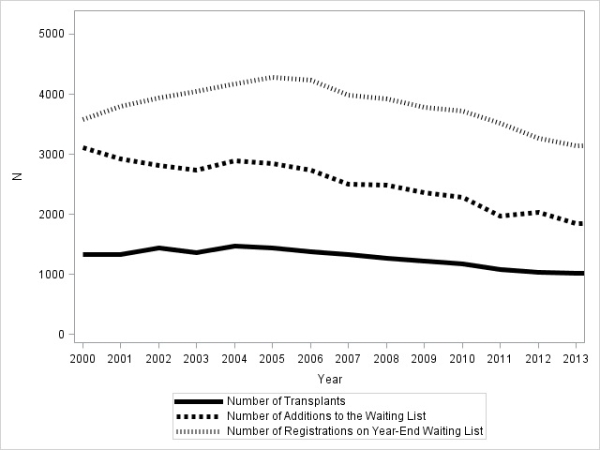Why Are Pancreas Transplant Volumes Declining?
1UNOS, Richmond, VA
2Indiana Univ School of Medicine, Indianapolis, IN
3Univ Wisconsin Hospital and Clinics, Madison, WI
4Massachusetts General Hospital, Boston, MA
5Univ of Maryland Medical System, Baltimore, MD.
Meeting: 2015 American Transplant Congress
Abstract number: 7
Keywords: Pancreas transplantation, Waiting lists
Session Information
Session Name: Concurrent Session: Controversies in Pancreas Transplantation
Session Type: Concurrent Session
Date: Sunday, May 3, 2015
Session Time: 2:15pm-3:45pm
 Presentation Time: 2:27pm-2:39pm
Presentation Time: 2:27pm-2:39pm
Location: Room 122-AB
Background: Pancreas transplant volumes have been decreasing in the US since the mid-2000s. It has been conjectured that poor utilization of deceased donor pancreata (as measured by high discard rates) is a leading cause of the decreasing transplant volumes. This study by the OPTN Pancreas Transplantation Committee aims to characterize other factors influencing the decline in pancreas transplantation.
Methods: Longitudinal trends in the numbers and demographics of the national pancreas waiting lists, pancreas deceased donation, and pancreas and kidney transplantation were analyzed.
Results: The number of pancreas transplants, including pancreas after kidney (PAK), simultaneous pancreas-kidney (SPK), and pancreas transplant alone (PTA), reached it's peak around 2004 and has declined since. SPK and PTA transplants have declined slowly, but PAK transplants have sharply declined in the last decade. Simultaneously, the number of annual additions to the pancreas waiting list has been steadily decreasing since 2000 and the overall waiting list size has sharply decreased since 2006. The percent of pancreata discarded after recovery from deceased donors nationally has not changed during that time. Donors are often not having pancreata recovered due to exhausting the waiting list and donor quality. Diabetic kidney-only recipients have been mostly type II, have high BMI and are older at the time of the kidney transplant.

Conclusions: Data does not show that pancreas discard rate has influenced the decline in pancreas transplant volume. The percent of pancreata recovered and discarded has not increased over the time that pancreas transplant volume has decreased. Contributing to this trend is that fewer candidates during this time have been added to the pancreas waiting list. Over time, diabetic kidney recipients have been increasingly type II, have higher BMI and are older at the time of the kidney transplant and likely do not qualify for a pancreas transplant.
To cite this abstract in AMA style:
Carrico R, Fridell J, Odorico J, Yeh H, Tyler K, Niederhaus S. Why Are Pancreas Transplant Volumes Declining? [abstract]. Am J Transplant. 2015; 15 (suppl 3). https://atcmeetingabstracts.com/abstract/why-are-pancreas-transplant-volumes-declining/. Accessed November 23, 2025.« Back to 2015 American Transplant Congress
